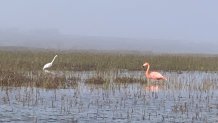Nobody knows for sure why a pair of flamingos have settled in the marsh by Coronado Cays, but they're sure brightening up the joint.
Some amateur ornithologists have speculated that the hot-pink pals are escapees from SeaWorld or the San Diego Zoo, a theory scoffed at by a zoo spokesman when the first bird showed up, insisting that they keep track of their flock. Also: Zoos usually "pinion" their birds, which is a polite way of saying they surgically remove a joint in the flamingos' wings, preventing them from taking off for friendlier climes — and the bird in Coronado didn't just walk over there.
Still others are convinced the animals, which can reach heights of four-and-a-half feet with wingspans approaching three-and-a-half feet, are just very, very lost and more likely belong in their native habitats of the Caribbean, Yucatan Peninsula of southern Mexico and Belize, or the Andean Plateau (which would make them very, very lost).
The most likely suspect is a third option: They're escapees from a private collection of some sort.
"Flamingoes are not native to San Diego and these birds have apparently escaped," Andrew Yuen, who is the project leader for the U.S. Fish and Wildlife Service's San Diego National Wildlife Refuge Complex, told NBC 7.
Asked where the flamingos came from, the folks at the wildlife refuge said, simply: "We do not know where [they] came from."
Welcome to Coronado Cays
What is known is that people in the Coronado Cays have welcomed the American flamingos (Phoenicopterus ruber) with open arms (wings?), according to Elsie Hammond, who reported about the birds in the Coronado Times newspaper. In fact, she said, a group of folks over there have pink-flamingo dock parties to celebrate their neighbors.

Floyd, who some want to believe is male — Yuen said the bird's gender is unknown — first put down in the marsh in February 2018 and has a band spotted on its leg, Yuen told the National Geographic that year, making this the probable explanation.
Nat Geo got wind of Floyd shortly after his arrival — pegged by the publication at Valentine's Day of that year — and reported that the U.S. Fish and Wildlife reintroduction of the tidal flow to Floyd's neighborhood in 2011 set the table for the return of all sorts of migrating birds, including members of the fushchia family.
"Numerous endangered and migratory birds, fish and marine invertebrates benefitted from the salt marsh restoration, and as it turns out, flamingos as well," the wildlife refuge staff told NBC 7 San Diego this week.
Floyd the Flamingo Finds a Friend
Floyd spent the next several years in quiet bachelorhood in the marsh at the far south end of San Diego Bay, down by Imperial Beach, noshing on plankton, algae and brine shrimp, but his solitude was not meant to be. Last year, another, smaller flamingo also put down in in the bay, having first made a pit stop in the nearby Tijuana Slough National Wildlife Refuge, according to staff at the wildlife refuge. That bird's relative size gave rise to speculation that it was a she.
However, the sex of that bird has not been determined, either, according to experts.
Speculation that the couple — if they are, in fact, a couple — does make some wonder if they might start a family, which, experts say, is an event that typically occurs in June, at least in the Caribbean.
Yuen and his team, though, are not on team Flamingo Family.

"The flamingos might be two males or two females," Yuen pointed out.
We can't help noticing June was a couple months ago, and ... no chicks.
Yes, but Why Are Flamingos That Color?
So: Why so pink? The Smithsonian National Zoo knows.
"Carotenoids give carrots their orange color or turn ripe tomatoes red," the zoo's website states. "They are also found in the microscopic algae that brine shrimp eat. As a flamingo dines on algae and brine shrimp, its body metabolizes the pigments — turning its feathers pink."
The food chain also attracts neighbors for Floyd and his friend, both of whom may live as long as 40 years.
"Flamingos feed on a variety of small invertebrates (plankton, mollusks, brine shrimp, etc.)," the wildlife refuge staff said. "The restoration of the tidal marshes at the San Diego Bay National Wildlife Refuge provides valuable food resources that have benefitted listed species like the light-footed Ridgway's rail and the California least tern, and these same habitats and food sources benefit the flamingos as well. Flamingos are also found in the salt ponds where they are probably feeding on brine shrimp and other invertebrates."
Where Can You See the Flamingos?
If you're wondering: How can you see them? Hammond told NBC 7 San Diego that she's ridden her standup paddleboard out to visit the pair, as well as driven by several times recently. In fact, she said she spotted them just days ago, she said.
The staff at the wildlife refuge also has tips on spotting the water fowl.
"The flamingos can occasionally be seen from the Bayshore Bikeway and the Bayside Birding and Walking Trail in the city of Imperial Beach," the staff said. "However, the flamingos are also observed in areas of the refuge that are closed to the public in order to protect seabirds and shorebirds."
The refuge staff pointed out that there are signs alerting birders and bird fans to not enter areas closed to the public, and that by not doing so, the flamingos and other native birds are given a "peaceful place to forage and rest."
What's in a Name?
Now, it seems, while Floyd's moniker is firmly entrenched, there's still some debate regarding his female friend, with Pinky seemingly the sobriquet of choice until 2023's boffo box office for, you guessed it, Barbie. After all, who's pinker than that?

